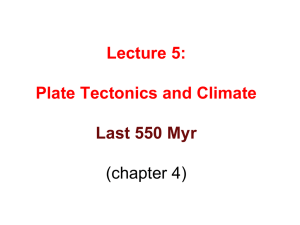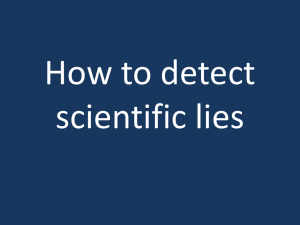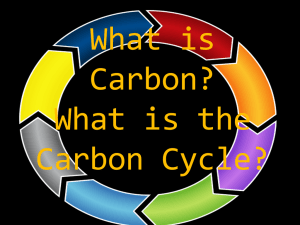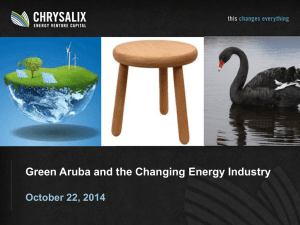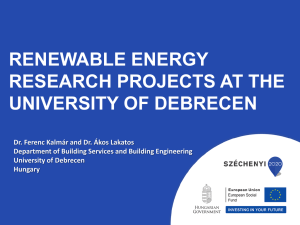L4_CO2 - Atmospheric and Oceanic Sciences
advertisement
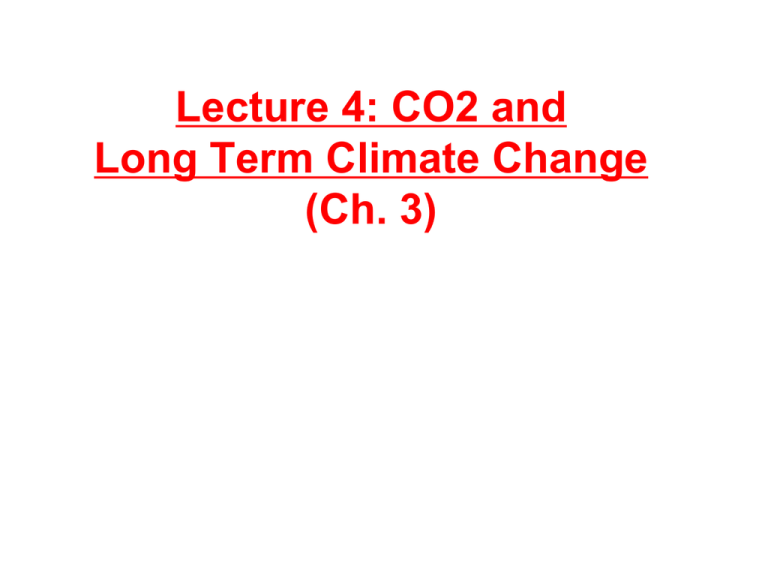
Lecture 4: CO2 and Long Term Climate Change (Ch. 3) Atmospheric CO2 Evolution Why Venus is hotter than Earth? Venus (460oC) vs. Earth (15oC) Why Venus (460oC) is hotter than the Earth (15oC) ? Answer 1: Venus is closer to the Sun Distance to the sun: Venus/Earth=0.72 radiation reach Venus/Earth = (12)/(0.722)=1.93 But, the albedo is 80% on Venus and 26% on Earth So the solar radiation received Venus/Earth = 1.93x (0.20/0.74)=0.52 So, Venus should be colder than the earth??? Answer 2: The CO2 GHG effect Venus vs. Earth The same amount of total carbon All carbon in the atmosphere Most carbon in rocks Carbon reservoirs on the earth 0.001% 0.025% 0.057% 99.9% Greenhouse Effect (1-)S Tg4 (1-)S glass T4 Heat fluxes: surface = (1-a)S + Tg4 - T4 =0 Top = (1-a)S - Tg4 = 0 (or radiation balance for the glass layer: 2 Tg4 = T4 ) Tg= ((1-a)S/ )1/4 = Tcc=255K , Tcg =21/4Tg=288oK=15oC About right… Major GHG on earth: H2O! Atmospheric CO2 Evolution Last 4.5 Byr: Why the earth is not that cold? ---The faint young Sun Paradox The faint young Sun paradox Assuming the same climate sensitivity: T~(S)1/4==> T4by/T0by~(S4by/S0by)1/4~(0.7)1/4~0.915 T4br=0.915*T0br=0.915*288K=263K= -10oC Would be frozen, But, incompatible with the evidence of premitive life found as far back as 3.5 Ba, In spite of the much weaker Sun (30%) in the early stage of the earth, the earth has remained inhabitable, instead of largely frozen (a snowball earth). Something keeps the earth warmer! But, this factor must not be functioning today, which otherwise would heat the present earth inhabitable? (above 25oC, at least) a thermostat (temperature regulator) is functioning! Was the Earth more like the Venus in the past, with more carbon in rocks? Carbon exchange Carbon Source: Volcanic Eruption Renewal /depletion time: Atmosphere: 600/0.15=4000 yr Combined surface reservoir: 3700/0.15=24,700yr Including deep ocean reservoir: 41,700/0.15=278,000yr, short compared with the history of the earth Volcanic flux is sufficient to provide carbon for the atmosphere (actually the entire surface earth system: atmos+soil+ocean) at long term 0.15 GT/yr But, volcanic eruption of CO2 has no direct feedback and therefore alone can’t form the thermostat mechanism! Some feedback that feels the climate is needed. Carbon sink: Chemical Weathering I Hydrolysis: CO2+H2O in the atmosphere removes CO2 from the atmosphere and is incorporated into ground water to form H2CO3 in soil, which attaches rocks and dissolve ions, and transported into the ocean in river, and store in the shells of marine plankton which eventually is deposited into the ocean bottom Hydrolysis : H2O (rain)+CO2 (air) CaSiO3 +H2CO3 Silicate rock Carbonic acid (Continent) soil CaCO3 +SiO2 +H2O shells of organism Carbon sink: Chemical Weathering II Dissolution: CO2+H2O in the atmosphere removes CO2 from the atmosphere and forms H2CO3 which attacks limestone caves, and the dissolved ions flow to the ocean in rivers. Dissolution : H2O (rain)+CO2 (air) CaCO3 +H2CO3 Limestone rock in soil CaCO3 +H2O + CO2 shells of organism return to air Different from hydrolysis Dissolution much faster but leads to no net removal of CO2 from the atmosphere So does not contribute to the lowering of CO2 in the long run Chemical weathering: earth’s thermostat through a higher temperature, rainfall and vegetation higher temperature increasing weather rate (10oC double rate) higher precipitation raise ground water level in the soil increasing weather rate Increase vege photosynthesis removal CO2 delivers into the soil where it combines with ground water to form H2CO3, increasing weather rate Chemical weathering forms the earth’s thermostat through T, P, V Chemical weathering is an excellent candidate for Earth’s thermostat A negative feedback mechanism for the fainted young Sun paradox: Weaker Sun => cooler/less P/less vege => less chemical weathering => More CO2 left in the atmosphere => stronger greenhouse effect =>compensates the weaker Sun. Chemical weathering is an excellent candidate for Earth’s thermostat (James Walker, Paul Hays and James Kastings) In contrast to chemical weathering, water vapor feedback is a positive feedback The Gaia Hypothesis The ultimate control of climate: Life Life itself has been responsible for regulating earth’s climate (J. Lovelock and L. Margulis, 1980) life is involved in the weathering process (vegetation, plankton shell…) warmermore plants/planktontakes CO2 downcooling Life and CO2 Organic carbon cycle, accounts for 20% of carbon fluxes Primitive system ineffective in the removal of atmospheric CO2 Root system effective removal of atmospheric CO2 Evolution of Life and CO2 removal efficiency The Debate on Gaia Hypothesis life is involved in the weathering process (vegetation, plankton shell…) (warmermore plants/planktontakes CO2 downcooling • Critics: early life too primitive to play an significant role in weathering, modern plants (root system) developed last 540 Ma marine shells develop after 540Ma (before chemical precip in shallow tropical seas…), • Support: bacteria in early time can help reduce CO2 too life evolution matches the earth’s need for progressively greater chemical weather through time. Later, more complex life leads to stronger weathering, reducing more CO2. Thermostat Malfunction: A Snowball Earth? 2-4 times glacial deposits, at least once in the tropics Chemical weathering not working: a 6% reduction of insolation, not cold enough Assuming the same climate sensitivity: T~(S)1/4==> T8Ma/T0Ma~(S8Ma/S0Ma)1/4~(0.94)1/4~0.985 T8Ma=0.985*T0Ma=0.985*288K=283K= 10oC So, a lower CO2 is needed (according to climate models). But, with chemical weathering thermostat, cooling reduced weathering higher CO2 Reading Material for L4 • Hoffman P. and D. Schrag, 2002: The snowball Earth hypothesis: testing the limits of global change. Terra Nova, 14, 129-155 • Schrag, D. Berner, R. , P. Hoffman and G. Halverson, 2002: On the initiation of a snowball Earth. Geocheistry, Geophysics, Geosystems, 3, 10.1029/2001GC000219 The End
